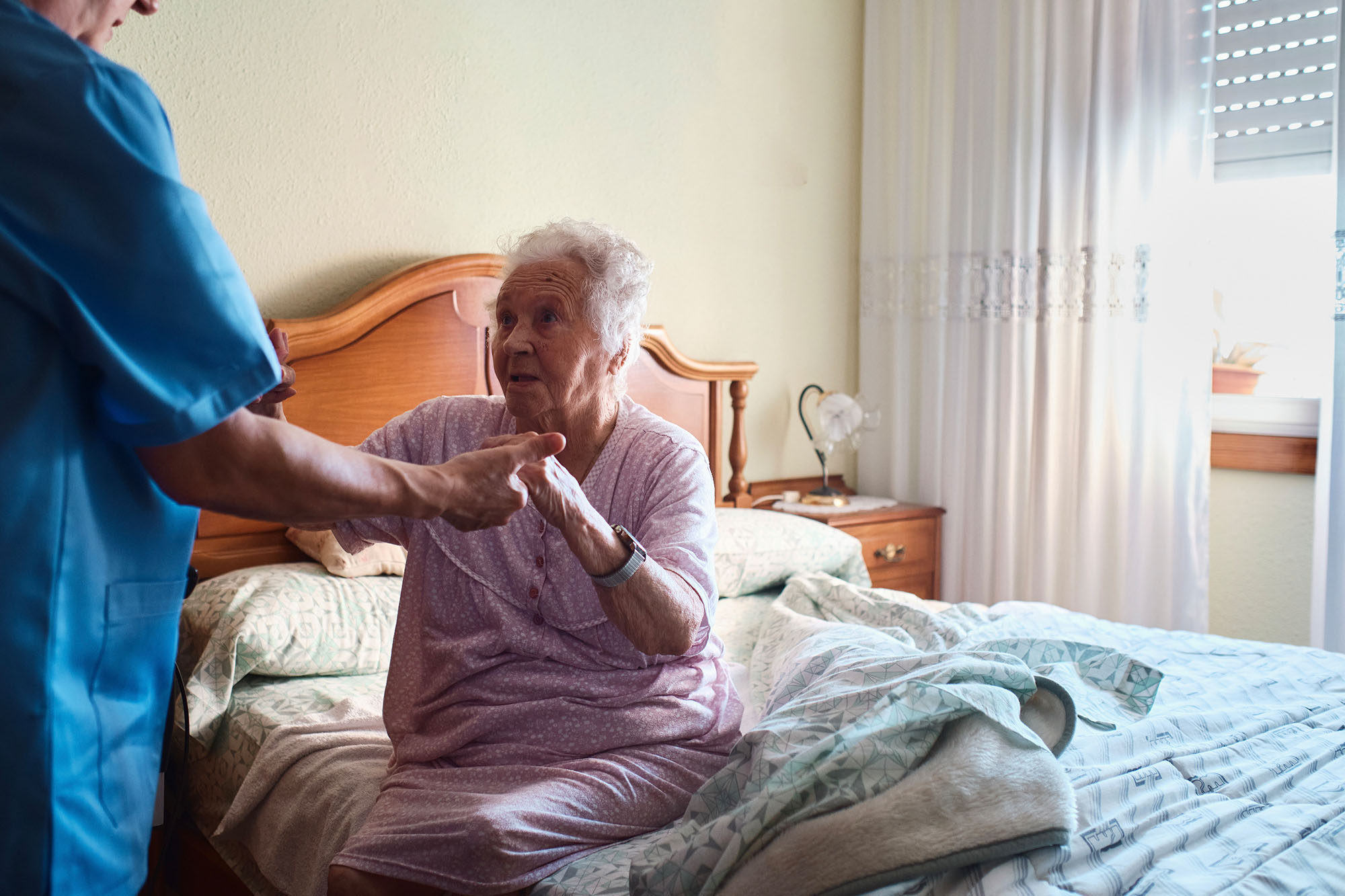Opportunity: Increase utilization of existing palliative care capacity.
Potential stakeholder actions:
- Engage with community to improve understanding of palliative care.
- Educate providers and case managers who care for people with serious illness about palliative care benefits.
- Implement processes to identify people who would benefit from palliative care and connect them to services.
- Integrate palliative care into existing medical and social programs that serve seriously ill populations.
Clinical capacity to offer palliative care (PC) is just one side of the equation. To ensure appropriate “demand” for palliative care, people with serious illness need to understand what palliative care is, how it can support them in complementary but different ways than their other medical services, and how to access PC services once they are desired. Organizations can contribute to generating and maintaining demand by establishing systems to identify people who could benefit from palliative care, communicating the benefits of these services to those who could benefit, initiating referrals, and following up on referrals to increase uptake.
Action: Engage with community to improve understanding of palliative care.
An estimated 71% of adults reported having never heard of palliative care, and communities of color are often even less aware.
Also, even when people say they know what palliative care is, their understanding can be inaccurate or incomplete, often conflating palliative care with hospice — including false beliefs that palliative care cannot be provided alongside other treatments. For some patients and caregivers from communities of color, these widespread misperceptions can be compounded by broader issues of mistrust caused by institutional racism and other forms of discrimination from health care systems, including a resulting concern that opting for PC might result in the withholding of curative care.
There is a significant opportunity to overcome these challenges and bolster the acceptance of palliative care by educating patients and families about what PC is and what benefits it brings. According to a 2019 survey commissioned by CHCF, when the services that palliative care offers were described, 9 in 10 Californians expressed their desire for this care in the event of a serious illness, regardless of their race or ethnicity.
“My responsibility, whether it’s a plan, whether it’s in a community agency, or even just as a social worker or a friend or a neighbor, is to empower people with the knowledge so that they can speak for themselves. We need to be in the community and educate the community members about what is palliative care, what is advance care planning and empower them with that knowledge so that they can go forward and discuss it with their primary care physicians. When I offered this education in the core of the community, people were thirsty for this knowledge.”
—Kim Beverly, MSW, MSG, Palliative Care Clinical Program Manager, Blue Shield of California
Ongoing community engagement activities can foster awareness and build trust in palliative care, leading to higher referral acceptance. Organizations responsible for the well-being of people facing serious illnesses could collaborate with community and faith-based organizations that already maintain trusted relationships within their community. Engagement activities should be codesigned with these trusted partners, and codesigners should pay special attention to language, the role of community champions as messengers, location of engagement activities, and a commitment to ongoing programming (see “Guiding Principles for Community Engagement”).
Guiding Principles for Community Engagement
Language and framing matter. Once people engage in a substantive discussion in straightforward language about palliative care and understand the services they would receive, enthusiasm for these supports become clear, as the 2019 CHCF survey underscored. The Serious Illness Messaging Toolkit (see “Resources from the Field” at the end of this section) can be a foundational resource for crafting messages. This toolkit, rooted in market research and testing, devised five strategies applicable to community engagement.
Messengers matter. Community engagement activities should encompass genuine interactions involving community members, palliative care clinicians, and peer ambassadors willing to share their personal experiences with palliative care as either patients or caregivers. It is crucial that patient and caregiver ambassadors are regarded as trusted figures within their communities (for instance, Black patients or caregivers engaging in predominantly Black communities). When possible, the palliative care clinician involved in outreach should also be a trusted member of the community. However, given the lack of racial and ethnic diversity within the palliative care clinician community (see Opportunity 1, “Equity”), this goal will not always be achievable.
Location and commitment matter. Community engagement activities should be conducted in collaboration with trusted community partners and advocates. These activities should take place in settings where people naturally gather and feel comfortable, such as senior centers, senior housing, places of worship, restaurants, or online environments. Activities must happen regularly (e.g., at least two to four times per year), rather than as isolated, one-off events. This approach helps establish the necessary trust, relationships, and knowledge within the community.
Action: Educate providers and case managers who care for people with serious illness about palliative care benefits.
Health systems and health plans should offer ongoing education on the value of palliative care to non-PC clinicians and health plan case managers. Clinicians and health plan staff do not always understand the benefits of palliative care and may even confuse it with hospice care. Misperceptions persist among some clinicians that referring patients to palliative care could cause loss of control over treatment decisions or is a sign of giving up on the patient. Continued education is a critical tool to drive demand and use of palliative care, notably:
- Educate non-PC clinicians. Health systems should provide education about the benefits of PC to all clinicians responsible for the care of people facing serious illness. This education explains the value of PC and teaches clinicians when and why to refer patients to PC. This education can be provided separately from generalist palliative care skills training.
- Educate case managers. Health plans should provide palliative care education to plan case managers to help them understand the value of PC and to become comfortable discussing PC as an option when reviewing services with seriously ill members or their caregivers. Case manager education could include shadowing opportunities to promote practical understanding of serious illness programs, as well as training videos, scripts, and practice sessions for describing palliative care to members.
“I’ve had several providers that initially did not understand the value of palliative care. But with education, advocacy, and patience, these providers changed their minds and now integrate palliative care into their care.”
—Cyndie Holzworth, RN, Director of Nursing — Outpatient Services, Hoffman Hospice & Palliative Care
Action: Implement processes to identify people who would benefit from palliative care and connect them to services.
Education alone is not enough. Purpose-built systems are beneficial to actively identify and refer patients into palliative care. Systems should encompass routine screening for palliative care needs, clear referral criteria, and a mechanism to start referrals when patients meet criteria. Although algorithm-based approaches can aid in patient identification, clinicians remain essential for recognizing people who may elude algorithmic detection. Additionally, clinicians play a crucial role in educating patients about the value of palliative care and helping them through the referral process. Over several years of collaborative efforts, Medi-Cal managed care plans have identified four promising practices. When used in combination, these practices optimize the identification of members who would benefit from palliative care:
- Data-driven strategies. Use of claims and other plan data to identify members with evidence of advanced serious illness, unaddressed symptoms, and other unmet needs.
- Plan care manager identification. Identification by health plan care managers, often from the panel of patients they are already managing under other complex case management programs or similar.
- Hospital-based staff engagement. Promotion of palliative care within hospital-based staff including hospitalists, hospital-based palliative care services, and discharge planners.
- Clinician referrals. Referrals from clinicians who care for large numbers of seriously ill people such as cardiologists, oncologists, and pulmonologists.
Action: Integrate palliative care into existing medical and social programs that serve seriously ill populations.
Even when people make the decision to accept a palliative care referral, they can still encounter challenges. These challenges can be rooted in practical matters such as cost of care, demands of transportation, or the physical challenges of getting to more appointments. Challenges can also be caused by emotional strain such as being overwhelmed by multiple teams managing or delivering care in the home.
Integrating palliative care into other existing medical and social programs that serve seriously ill populations not only simplifies the process of accepting services for patients, but also reduces the burden of accessing care. Further elaboration on this opportunity is provided in Opportunity 8, “Integration.”
Resources from the Field
- Help Wanted: Californians’ Views and Experiences of Serious Illness and End-of-Life Care (CHCF)
- The Serious Illness Messaging Toolkit
- Introduction to Palliative Care for Health Professionals (Center to Advance Palliative Care [CAPC])
- Conversation Skills for Introducing Palliative Care: New Video Tools (Coalition for Compassionate Care of California)
- Care Managers: Addressing the Unique Needs of Patients with Serious Illness (CAPC)
- Essential Care Management Training for Health Plans (California State University Shiley Haynes Institute for Palliative Care)
- Community House Calls Program (Harborview Medical Center)
Actions for Stakeholders
Learn more about each action (PDF), including how all stakeholders can commit to this opportunity. Please be aware that actions for stakeholders to support “Action: Integrate palliative care into existing medical and social programs that serve seriously ill populations” are included under Opportunity 8, “Integration.”
For full source information, see California’s Palliative Care Evolution — Opportunities to Further Advance Palliative Care in California (PDF).






